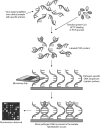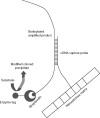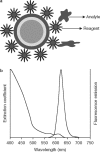Molecular and nanotechnologic approaches to etiologic diagnosis of infectious syndromes
- PMID: 21766906
- PMCID: PMC7100041
- DOI: 10.1007/BF03256405
Molecular and nanotechnologic approaches to etiologic diagnosis of infectious syndromes
Abstract
Infectious diseases are a major global public health problem. Multiple agents are now recognized to cause indistinguishable illnesses. The term 'syndrome' applies to such situations, for which early and rapid diagnosis of the infecting agent would enable prompt and appropriate therapy. Public health physicians would also get timely information on the specific etiology of the infectious syndrome, facilitating intervention at the community level in the face of outbreaks or epidemics. A variety of molecular techniques have been evaluated for rapid diagnosis of infectious syndromes. These techniques include real-time multiplex PCR, DNA microarray, loop-mediated isothermal amplification, and other similar assays. This review surveys such state-of-the-art technologies.
Figures





Similar articles
-
Role of molecular diagnostics in the management of infectious disease emergencies.Med Clin North Am. 2012 Nov;96(6):1067-78. doi: 10.1016/j.mcna.2012.08.005. Epub 2012 Sep 27. Med Clin North Am. 2012. PMID: 23102477 Free PMC article. Review.
-
Advances in the application of molecular diagnostic techniques for the detection of infectious disease pathogens (Review).Mol Med Rep. 2023 May;27(5):104. doi: 10.3892/mmr.2023.12991. Epub 2023 Apr 7. Mol Med Rep. 2023. PMID: 37026505 Free PMC article. Review.
-
PCR/LDR/universal array platforms for the diagnosis of infectious disease.Methods Mol Biol. 2010;632:141-57. doi: 10.1007/978-1-60761-663-4_9. Methods Mol Biol. 2010. PMID: 20217576 Free PMC article.
-
Nucleic acid approaches for detection and identification of biological warfare and infectious disease agents.Biotechniques. 2003 Oct;35(4):862-9. doi: 10.2144/03354ss03. Biotechniques. 2003. PMID: 14579752
-
Application of nanomaterials to arrays for infectious disease diagnosis.Nanomedicine (Lond). 2011 Feb;6(2):271-80. doi: 10.2217/nnm.10.161. Nanomedicine (Lond). 2011. PMID: 21385129 Review.
Cited by
-
Application of viromics: a new approach to the understanding of viral infections in humans.Virusdisease. 2017 Dec;28(4):349-359. doi: 10.1007/s13337-017-0415-3. Epub 2017 Dec 5. Virusdisease. 2017. PMID: 29291225 Free PMC article. Review.
-
A multiplex nested PCR for the simultaneous detection of Salmonella typhi, Mycobacterium tuberculosis, and Burkholderia pseudomallei in patients with pyrexia of unknown origin (PUO) in Vellore, South India.Mol Diagn Ther. 2014 Jun;18(3):315-21. doi: 10.1007/s40291-013-0079-7. Mol Diagn Ther. 2014. PMID: 24385404
-
Role of molecular diagnostics in the management of infectious disease emergencies.Med Clin North Am. 2012 Nov;96(6):1067-78. doi: 10.1016/j.mcna.2012.08.005. Epub 2012 Sep 27. Med Clin North Am. 2012. PMID: 23102477 Free PMC article. Review.
References
-
- Curr Opin Pediatr. 2009.
Publication types
MeSH terms
LinkOut - more resources
Full Text Sources
Medical
Molecular Biology Databases

